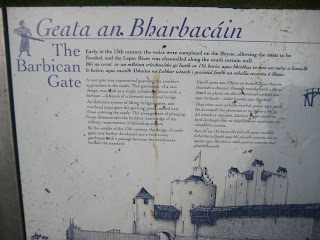
The Castle was used as a centre of Norman administration for the Liberty of Meath, one of the new administrative areas of Ireland created by Henry II of England and granted to Hugh de Lacy. de Lacy took possession of it in 1172. De Lacy built a huge ringwork castle defended by a stout double palisade and external ditch on top of the hill. There may also have been further defences around the cliffs fringing the high ground. Part of a stone footed timber gatehouse lies beneath the present stone gate at the west side of the castle. The ringwork was attacked and burnt by the Irish but De Lacy immediately rebuilt it in 1173. His son Walter continued rebuilding and the castle was completed c 1204. The next phase of the castle’s construction took place at the end of the 13th century, and the beginning of the 14th century. A new Great Hall with undercroft beneath it and an with attached solar in a radically altered curtain tower, and a new forework forebuilding, and stables were added to the keep. After de genneville's death his widow Joan married Roger Mortimer and the castle passed to the Mortimer family who held it until the lord of Trim became Edward IV king of England in 1461.
The castle site was chosen because it is on raised ground, overlooking a fording point over the River Boyne. The castle was an important early medieval ecclesiastical and royal site, and although the site is about 25 miles from the Irish Sea, it was accessible in medieval times by boat up the River Boyne. Trim Castle is referred to in the Norman poem “The Song of Dermot and the Earl.”
During the late Middle Ages, Trim Castle was the centre of administration for Meath and marked the outer northern boundary of The Pale. In the 16th and 17th centuries it had declined in importance, except as a potentially important military site, and the castle was allowed to deteriorate. During the 15th century the Irish Parliament met in Trim Castle seven times and a mint operated in the castle. It fell into decline in the 16th century but was refortified during the Cromwellian wars in the 1640s.
After the wars of the 1680s, the castle was granted to the Wellesle family who held it until Arthur Wellesley (the Dike of Wellington), sold it to the Leslies. In following years it passed via the Encumbered Estates Court into the hands of the Dunsany Plunketts. They left the lands open and from time to time allowed various uses, with part of the Castle Field rented by the Town Council as a municipal dump for some years, and a small meeting hall for the Royal British Legion erected. The Dunsanys held the Castle and surrounds until 1993, when after years of discussion, Lord Dunsany sold the land and buildings to the State, retaining only river access and fishing rights.
The Office of Public Works began a major programme of conservation and exploratory works, costing over six million euro, including partial restoration of the moat and the installation of a protective roof. The castle was re-opened to the public in 2000.




 The Castle is noted for the part it played in the filming of the Mel Gibson directed film Braveheart.
The Castle is noted for the part it played in the filming of the Mel Gibson directed film Braveheart.


 So beautiful!!!!!
So beautiful!!!!!
Are there apartments for rent in Trim or nearby?
ReplyDelete